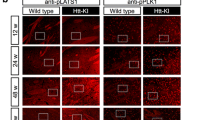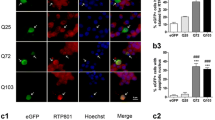Abstract
Rybp (DEDAF) has been shown to interact with DED-containing proteins and to encode pro-apoptotic functions. Here we characterize a novel interaction between Rybp and Hippi, a protein implicated in neuronal apoptosis as well as in the pathogenesis of Huntington’s disease. Rybp can synergize with Hippi to enhance Caspase 8-mediated apoptosis and also appears to be essential for Hippi-mediated apoptosis. Moreover, Rybp may mediate or regulate the interaction between Hippi and Caspase 8. Finally, Rybp and Hippi co-localize in a subset of neurons in the developing mouse brain. Together, these findings suggest that Rybp and Hippi may functionally interact in the apoptotic processes that accompany normal murine neural development.






Similar content being viewed by others
Abbreviations
- AS:
-
Antisense
- CT:
-
Carboxyl terminus
- DED:
-
Death effector domain
- DEDAF:
-
Death effector domain associated factor
- FADD:
-
Fas associated protein with Death Domain
- Hip1:
-
Huntingtin interacting protein 1
- Hippi:
-
Hip1 protein interactor
- MLD:
-
Myosin like domain
- NT:
-
Amino terminus
- NZF:
-
Npl4 zinc finger
- pDED:
-
Pseudo-death effector domain
- Rybp:
-
Ring1 and YY1 binding protein
- Yaf2:
-
YY1 activating factor 2
- YY1:
-
Ying Yang 1
References
Garcia E, Marcos-Gutierrez C, del Mar Lorente M, Moreno JC, Vidal M (1999) RYBP, a new repressor protein that interacts with components of the mammalian Polycomb complex, and with the transcription factor YY1. Embo J 18(12):3404–3418
Sawa C, Yoshikawa T, Matsuda-Suzuki F, Delehouzee S, Goto M, Watanabe H, Sawada J, Kataoka K, Handa H (2002) YEAF1/RYBP and YAF-2 are functionally distinct members of a cofactor family for the YY1 and E4TF1/hGABP transcription factors. J Biol Chem 277(25):22484–22490
Bejarano F, Gonzalez I, Vidal M, Busturia A (2005) The Drosophila RYBP gene functions as a Polycomb-dependent transcriptional repressor. Mech Dev 122(10):1118–1129
Schlisio S, Halperin T, Vidal M, Nevins JR (2002) Interaction of YY1 with E2Fs, mediated by RYBP, provides a mechanism for specificity of E2F function. EMBO J 21(21):5775–5786
Trimarchi JM, Fairchild B, Wen J, Lees JA (2001) The E2F6 transcription factor is a component of the mammalian Bmi1-containing polycomb complex. Proc Natl Acad Sci USA 98(4):1519–1524
Arrigoni R, Alam SL, Wamstad JA, Bardwell VJ, Sundquist WI, Schreiber-Agus N (2006) The Polycomb-associated protein Rybp is a ubiquitin binding protein. FEBS Lett 580(26):6233–6241
Zheng L, Schickling O, Peter ME, Lenardo MJ (2001) The death effector domain-associated factor plays distinct regulatory roles in the nucleus and cytoplasm. J Biol Chem 276(34):31945–31952
Danen-van Oorschot AA, Voskamp P, Seelen MC, van Miltenburg MH, Bolk MW, Tait SW, Boesen-de Cock JG, Rohn JL, Borst J, Noteborn MH (2004) Human death effector domain-associated factor interacts with the viral apoptosis agonist Apoptin and exerts tumor-preferential cell killing. Cell Death Differ 11(5):564–573
Scott GK, Mattie MD, Berger CE, Benz SC, Benz CC (2006) Rapid alteration of microRNA levels by histone deacetylase inhibition. Cancer Res 66(3):1277–1281
Pirity MK, Locker J, Schreiber-Agus N (2005) Rybp/DEDAF is required for early postimplantation and for central nervous system development. Mol Cell Biol 25(16):7193–7202
Lossi L, Merighi A (2003) In vivo cellular and molecular mechanisms of neuronal apoptosis in the mammalian CNS. Prog Neurobiol 69(5):287–312
Gervais FG, Singaraja R, Xanthoudakis S, Gutekunst CA, Leavitt BR, Metzler M, Hackam AS, Tam J, Vaillancourt JP, Houtzager V, Rasper DM, Roy S, Hayden MR, Nicholson DW (2002) Recruitment and activation of Caspase-8 by the Huntingtin-interacting protein Hip-1 and a novel partner Hippi. Nat Cell Biol 4(2):95–105
Majumder P, Chattopadhyay B, Mazumder A, Das P, Bhattacharyya NP (2006) Induction of apoptosis in cells expressing exogenous Hippi, a molecular partner of huntingtin-interacting protein Hip1. Neurobiol Dis 22(2):242–256
Cheng CM, Huang SP, Chang YF, Chung WY, Yuo CY (2003) The viral death protein Apoptin interacts with Hippi, the protein interactor of Huntingtin-interacting protein 1. Biochem Biophys Res Commun 305(2):359–364
Majumder P, Chattopadhyay B, Sukanya S, Ray T, Banerjee M, Mukhopadhyay D, Bhattacharyya NP (2007) Interaction of HIPPI with putative promoter sequence of Caspase-1 in vitro and in vivo. Biochem Biophys Res Commun 353(1):80–95
Majumder P, Choudhury A, Banerjee M, Lahiri A, Bhattacharyya NP (2007) Interactions of HIPPI, a molecular partner of Huntingtin interacting protein HIP1, with the specific motif present at the putative promoter sequence of the Caspase-1, Caspase-8 and Caspase-10 genes. Febs J 274(15):3886–3899
Tsujikawa M, Malicki J (2004) Intraflagellar transport genes are essential for differentiation and survival of vertebrate sensory neurons. Neuron 42(5):703–716
Kramer-Zucker AG, Olale F, Haycraft CJ, Yoder BK, Schier AF, Drummond IA (2005) Cilia-driven fluid flow in the zebrafish pronephros, brain and Kupffer’s vesicle is required for normal organogenesis. Development 132(8):1907–1921
Rosenbaum JL, Witman GB (2002) Intraflagellar transport. Nat Rev Mol Cell Biol 3(11):813–825
Houde C, Dickinson RJ, Houtzager VM, Cullum R, Montpetit R, Metzler M, Simpson EM, Roy S, Hayden MR, Hoodless PA, Nicholson DW (2006) Hippi is essential for node cilia assembly and Sonic hedgehog signaling. Dev Biol 300(2):523–533
Dugast-Darzacq C, Pirity M, Blanck JK, Scherl A, Schreiber-Agus N (2004) Mxi1-SRalpha: a novel Mxi1 isoform with enhanced transcriptional repression potential. Oncogene 23(55):8887–8899
Schreiber-Agus N, Chin L, Chen K, Torres R, Thomson CT, Sacchettini JC, DePinho RA (1994) Evolutionary relationships and functional conservation among vertebrate Max-associated proteins: the zebra fish homolog of Mxi1. Oncogene 9(11):3167–3177
Stanton SE, McReynolds LJ, Evans T, Schreiber-Agus N (2006) YAF2 inhibits Caspase 8-mediated apoptosis and regulates cell survival during zebrafish embryogenesis. J Biol Chem 281(39):28782–28793
Ribble D, Goldstein NB, Norris DA, Shellman YG (2005) A simple technique for quantifying apoptosis in 96-well plates. BMC Biotechnol 5:12
Ho PK, Hawkins CJ (2005) Mammalian initiator apoptotic Caspases. Febs J 272(21):5436–5453
Zhang HG, Wang J, Yang X, Hsu HC, Mountz JD (2004) Regulation of apoptosis proteins in cancer cells by ubiquitin. Oncogene 23(11):2009–2015
Sakamaki K, Inoue T, Asano M, Sudo K, Kazama H, Sakagami J, Sakata S, Ozaki M, Nakamura S, Toyokuni S, Osumi N, Iwakura Y, Yonehara S (2002) Ex vivo whole-embryo culture of Caspase-8-deficient embryos normalize their aberrant phenotypes in the developing neural tube and heart. Cell Death Differ 9(11):1196–1206
Kruidering M, Evan GI (2000) Caspase-8 in apoptosis: the beginning of “the end”? IUBMB Life. 50(2):85–90
Ashley DM, Riffkin CD, Muscat AM, Knight MJ, Kaye AH, Novak U, Hawkins CJ (2005) Caspase 8 is absent or low in many ex vivo gliomas. Cancer 104(7):1487–1496
Gonzalez-Gomez P, Bello MJ, Inda MM, Alonso ME, Arjona D, Aminoso C, Lopez-Marin I, de Campos JM, Sarasa JL, Castresana JS, Rey JA (2004) Deletion and aberrant CpG island methylation of Caspase 8 gene in medulloblastoma. Oncol Rep 12(3):663–666
Acknowledgments
We thank the members of the Schreiber-Agus laboratory for their thoughtful insight, comments on this work, and for providing unpublished plasmid constructs. We also thank Lisa McReynolds and Todd Evans for help with the Acridine Orange/Ethidium Bromide assay microscopy, and Harry Hou for providing the newborn mice. The sectioning and staining for the immunohistochemistry was performed by Dr. Radma Mahmood and the Histopathology Shared Resource Center of the Albert Einstein Cancer Center. Data in this paper are from a thesis (SES) submitted in partial fulfillment of the requirements for the Degree of Doctor of Philosophy in the Graduate Division of Medical Sciences, Albert Einstein College of Medicine, Yeshiva University. This work was supported in part by NIH Public Health Service grants CA92558 (NSA), CA68440 (JL), CA104292 (JL), NIH Medical Scientist Training Program Grant T32GM07288 (SES), and the Albert Einstein Cancer Center (NSA and JL).
Author information
Authors and Affiliations
Corresponding authors
Rights and permissions
About this article
Cite this article
Stanton, S.E., Blanck, J.K., Locker, J. et al. Rybp interacts with Hippi and enhances Hippi-mediated apoptosis. Apoptosis 12, 2197–2206 (2007). https://doi.org/10.1007/s10495-007-0131-3
Published:
Issue Date:
DOI: https://doi.org/10.1007/s10495-007-0131-3




